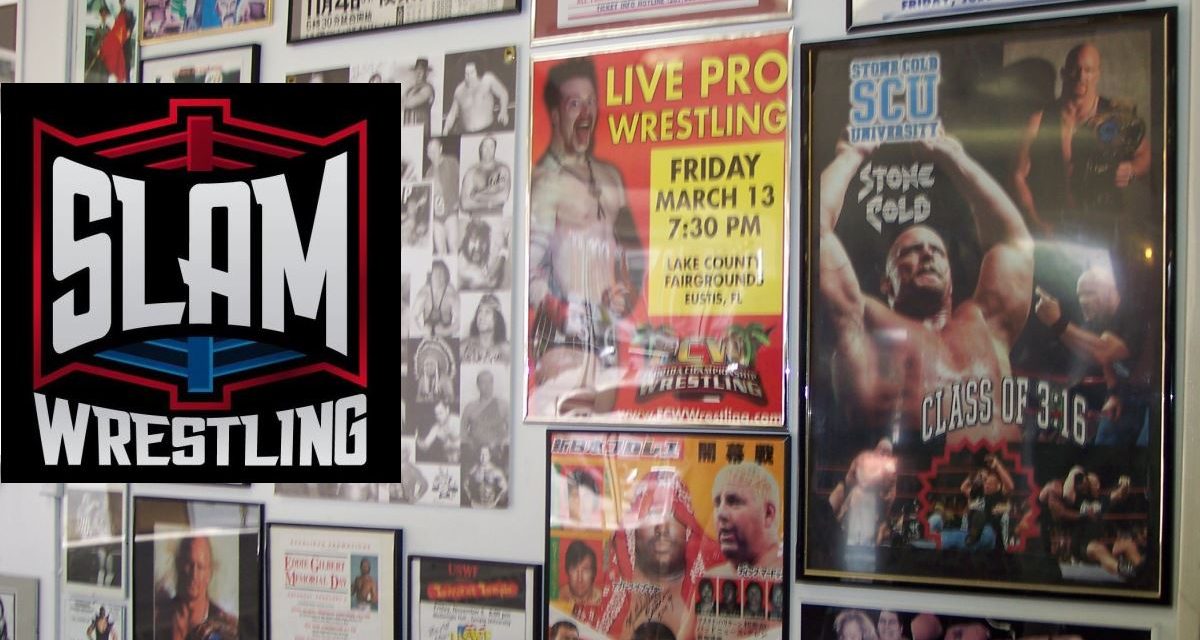Tony Vellano is well-known as the founder of the Professional Wrestling Hall of Fame & Museum (PWHF) and also as its president from the PWHF’s incorporation in 1999 until its move from New York to Texas in 2016. The few people who have observed the materialization of Tony’s vision to create the first successful brick-and-mortar exclusively pro wrestling hall of fame may more appropriately refer to Vellano as the “heart and soul” of the PWHF.
Growing up, Vellano had an intense interest in boxing and, in exchange for admission to the fights, he would help set up the ring, tape water bottles and perform other tasks that the promoter may assign to him. In 1995, the New York State Athletic Commission (NYSAC) needed additional Inspectors in the Adirondack region and invited Vellano to apply for the position. Tony was hired and, as expected, he excelled at his work to the point of being appointed a NYSAC Deputy Commissioner in 2000. The NYSAC also regulates professional wrestling and Vellano began to supervise wrestling shows. His only prior knowledge of pro wrestling was using it as a “time killer” while waiting to watch the television shows that he actually wanted to see.
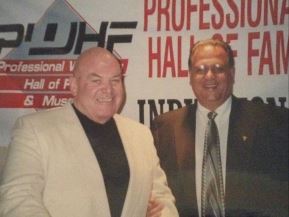
George Steele and Tony Vellano in the early days of the Pro Wrestling Hall of Fame.
A confluence of two aspects of Vellano’s life converged to spawn the birth of the PWHF. The first was Vellano’s tenure since 1990 on the Board of Directors of the International Boxing Hall of Fame, located in Canastota, New York. The second was a September 1999 conversation at a bar with George “The Animal” Steele following a wrestling show that Tony supervised. During that chat, Vellano asked Steele where the professional wrestling hall of fame was located. Vellano was surprised to hear that there was no such entity and they began speaking of plans to start one. Steele later stated that he never took the exchange seriously, figuring that it was just small talk over drinks.
Three months later, the Animal received a phone call from Vellano telling him that he had sought out and received approval by the New York State Board of Regents for a not-for-profit PWHF corporate charter. Steele told Vellano that he barely remembered their conversation but nonetheless pledged to be true to his word and help develop the nascent group. Steele, who became a PWHF Board of Directors member, began to contact wrestlers asking for both memorabilia and moral support. Steele supplied the credibility needed to gain the confidence of his fellow wrestling stars, who were justifiably skeptical about donating their time and wrestling relics to a wrestling museum that did not yet have a physical location.
When the Wrestling Observer Newsletter mentioned that a man named Tony Vellano was forming a professional wrestling hall of fame, I remember thinking that such an endeavor would most likely be impossible. After all, others had unsuccessfully tried. Despite having been interested in, and close to, pro-wrestling for five decades, I had not heard of Vellano. My father had been a ringside physician and I accompanied him into wrestling dressing rooms since age seven. In later years, I wrote articles, began collecting memorabilia and ran several shows, including the sole Utica, New York AWA appearance in 1985. I volunteered to help the PWHF assuming that it would only last a few months after this unknown man realized what a Herculean task he had put in front of himself. As those months turned into years, no one was more surprised than me.
I remember giving Tony my opinion that if the PWHF was to become a success, it would be because he was a businessman — his family has operated The Vellano Corp., serving contractors and workers in the water and waste industry, since the 1920s — and not a wrestling enthusiast. Wrestling fans, as well as wrestlers, have their own biases regarding issues related to their beloved sport. Vellano had no such prejudices and looked at the PWHF as he would with any of his other successful business ventures. As Tony put it, “I am an organizational guy. I knew how to put things together and my construction background taught me how to read the blueprint and to know what subcontractors I needed to complete the project. That is how I approached setting up the PWHF.”
Vellano created the initial PWHF Board of Directors in a logical manner and chose the people needed for all contingencies including a lawyer, a banker, a computer literate person, a museum expert, a public relations person, an insurance agent, an accountant, a few professional wrestlers and several successful business people. I was not on that original list, because Vellano did not want anyone on both the Board of Directors and the Board of Selectors and I chose the Board of Selectors because it was wrestling-related as opposed to business-related. He felt that it would be a conflict of interest to serve on both.
After assembling the best team possible, Vellano had to file papers to incorporate for 501c3 not-for-profit status, obtain Board of Directors insurance, a chequing account, a logo, and let the world know that the PWHF was in business but without a brick-and-mortar building — yet.
To convince local politicians of the practicality of his goal, Vellano attended civic meetings and spoke of his ideas. Over time, Schenectady county legislators, through the Metroplex project, told Vellano that they had allocated $250,000 for his concept. An April 2001 sold-out fundraising dinner was held at the historic 300-year-old Glen Sanders Mansion and was highlighted by an appearance by George Steele. The architectural plans for the PWHF facility were ceremoniously unveiled by local dignitaries with appropriate press coverage. The PWHF was off and running.
Whoa, Nellie!
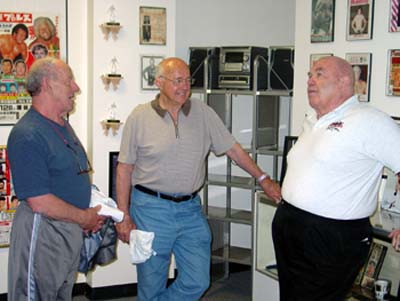
Len Rossi, Verne Gagne and George Steele talk at the original PWHF in Schenectady. Photo by Steven Johnson
The promised quarter million dollar funding vanished after the dinner. If you thought that such a gut-wrenching blow would deter Vellano from his appointment with destiny, you would be grossly mistaken. As he put it, “as for quitting, that was never an option.”
Despite the many hurdles encountered in the early days, occasionally there would be a few rays of sunshine to give hope for creating a real home for professional wrestling. At the first Board of Directors meeting, a cheque for $2,000 was donated by M&T bank, which Vellano had chosen to be the official bank of the PWHF. To raise additional money, Vellano sold PWHF memorabilia, improvised autograph sessions, searched for individual and corporate sponsorships and applied for grants from New York State. New York State Senator Hugh Farley, a former Army boxer, was extremely helpful in obtaining some initial funding for the PWHF’s first few years. Those funds successfully served their intended purpose of increasing tourism and business activity in the central New York State region. However, some, including elitists in the news media, deemed that such an expenditure for anything related to professional wrestling was a waste of taxpayer money and the grants ceased.
The first PWHF headquarters was located in Vellano’s hometown of Schenectady, New York. As fate would have it, the actual address was “1-2-3 Broadway,” which had a familiar ring to wrestling fans aware of the significance of those numbers followed by the term used to indicate a match that is intended to end in a draw. Vellano searched for months for an affordable location for the initial PWHF office and museum. He admitted that he did not realize the significance of the Broadway address until he called Steele to inform him that a suitable building was secured.
At 1,000 square feet, it may not have been as impressive as Cooperstown’s National Baseball Hall of Fame and Museum but these few rooms were tantamount to a little bit of Heaven on Earth for wrestling fans. There was a lot of empty wall space in the beginning and it seemed it would take forever to make them look even respectably full. As wrestlers and fans began to appreciate the altruistic efforts that were being made to honour the men and women who provided excitement and entertainment for millions of fans throughout the world, donations slowly filled the walls. When the PWHF eventually had a grand opening event at the Schenectady location, New York State Senator James Tedisco was in attendance. I told him that I hoped that the PWHF would be able to survive all the hurdles placed in front of it. Tedisco responded, “Tony Vellano doesn’t get involved with things that fail.”
One quirk of that original museum was that we had no control over the heating or the air conditioning as the PWHF rooms were part of a larger multi-use building. We froze in the winter because of the lack of heat and we froze in the summer because we could not adjust the air conditioning system. One winter day, Tony was so cold that he had to take Bobby Heenan’s sweatshirt out of a display and wear it to prevent possible hypothermia. In the summer, I had to periodically go outside to prevent hypothermia.
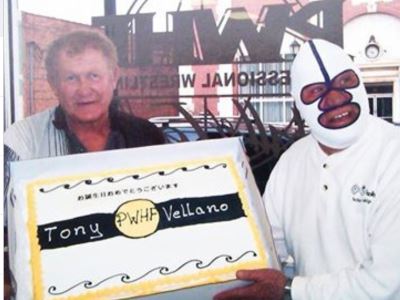
Harley Race and the Destroyer have a cake for Tony Vellano.
Tony’s lack of knowledge regarding wrestling was a supreme blessing for the establishment of the PWHF. When I brought him the list of 2004 inductees, which included Harley Race, Verne Gagne, Lord Littlebrook, Terry Funk and The Great Johnnie Mae Young, Tony did not recognize those names and asked if they would attract attendees for the our annual ceremonies. As time went on, I was impressed with Tony’s ability to learn so much about wrestling’s history in a relatively short period. He would read the wrestling books at the PWHF library to familiarize himself with pertinent topics and any knowledge gained from talking to wrestlers and historians became permanently embedded in his mind. However, had he been partial to certain styles, territories or organizations, the PWHF would not have flourished as a place where ALL wrestling fans and in-ring participants were equally treated.
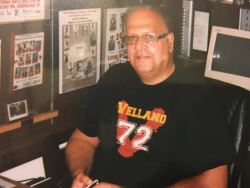
Tony Vellano in his office in Amsterdam.
Tony was quite adept at dealing with the occasional over-inflated ego. One wrestling superstar demanded a first-class airline ticket to attend his induction. PWHF policy was to give the invited wrestlers coach rate fare as every dollar saved was a dollar that could be put to use to improve the museum. When told that a first-class ticket would not be forthcoming from the PWHF, the former mat star demanded a return of his previously donated memorabilia and did so with an accompanying vulgarity-infused email. Tony’s sole response was to ask what address to use to return his memorabilia. Ironically, Tony told me that he may have been able to find a PWHF supporter to buy the requested plane upgrade but the self-interested celebrity was too overwhelmed by his own importance that he never allowed Tony to make that offer.
After several years, the city of Schenectady needed the PWHF space for an urban renewal project. Through persistent contacts with various city governments, Vellano was able to secure a win-win deal with the small city of Amsterdam, New York. The city, located just off the Interstate and about 45 minutes from the capitol in Albany, agreed to lease the PWHF building for one dollar per year as long as the PWHF renovated the building. Much of the actual carpentry for the renovations was personally performed by Tony and a few volunteers. As time went on, the PWHF obtained a similar contract for the adjacent building. Len Rossi and I once commented how Tony reminded us of Donald Trump because Tony had a unique way of making mutually beneficial real estate deals.
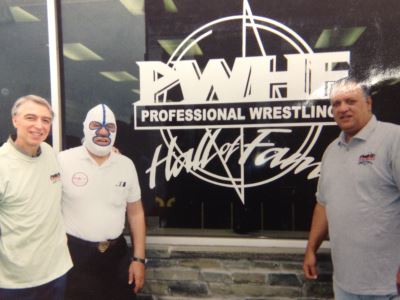
Dr. Bob. Bryla, The Destroyer Dick Beyer and Tony Vellano outside the Amsterdam PWHF.
The businesses nearby the Amsterdam PWHF were very welcoming and Vellano made a point of befriending the owners. Eventually, through Vellano’s prompting, the downtown section of Amsterdam began having street fairs concurrent with the PWHF Induction Weekends. Thousands of people came to patronize the vendors and to visit the PWHF.
When a new Amsterdam mayor was elected, Ann Thane, she was interviewed in the local paper and made disparaging remarks about the PWHF. Tony sent me a copy of the email that he sent to her in response to that article and it was truthful yet brutal. He asked her how she could know anything about the PWHF since she had never set foot in our museum nor had she ever spoken to PWHF officials. He asked her to name another organization in Amsterdam that annually sells out the local hotels as well as increasing every other tourist-related activity. Incidentally, the annual induction influx caused at least one bar to run out of glasses because they were all in use at the same time. An Amsterdam bartender actually asked Ray “Doink” Apollo to return his glass before he was finished with his drink. Ray told the bartender that the deal they made when he bought the drink was that he was able to use the glass it came in until the drink was finished. The bartender had apparently never experienced such a large crowd before.
After reading Tony’s email to the mayor, I remember thinking that this mayor will be our nemesis as long as she is in office. Months later, I came into the hall for my Saturday volunteer work. Tony told me that if I’d like to meet the mayor, I could go out to the back of the hall where she was painting our wall. Tony is capable of pulling some practical jokes and I figured this was one but I’d go out back to see what this prank was. Sure enough, the mayor was painting our back wall! Despite the aforementioned chillingly direct email to her, Tony’s determination was rewarded with a PWHF convert. The mayor later spoke at a PWHF induction banquet and said that she initially did not understand professional wrestling but was high in her praise of what the PWHF did to promote business in Amsterdam.
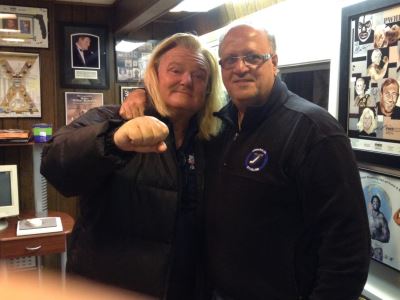
Greg “The Hammer” Valentine and Tony Vellano.
Although Tony has many qualities that define a leader, the one that made his small core of volunteers so loyal was that he would never ask anyone else do something that he wouldn’t do himself. Those tasks included everything from sweeping the floors to painting the walls to washing the windows. I’ve watched Tony and his son-in-law carry a furnace into the hall and I’ve seen Tony move large display cases by himself. One day, Tony needed to put concrete into pails to make upright holders to support barrier ribbons surrounding the displays. We didn’t have the proper equipment available to pour the concrete so Tony and I used our hands. Tony said that someday we’d laugh about it and I know that I have. The PWHF would have a huge bank account if it had a nickel for every unfulfilled promise from so many people who may have been well-intentioned but were unequipped to make good on their pledges to help. Some volunteers wanted to be there for the fun times but they were not to be found when work needed to be done.
Bruno Sammartino was a member of the very first PWHF Induction Class of 2002. Since the PWHF was a new and untested organization, he chose not to attend the festivities that year. Over time, Bruno’s close friends “Irish” Davey O’Hannon, a PWHF Board of Directors member, and Dominic DeNucci, PWHF Class of 2012, as well as Tony, persisted in asking Bruno to come to an induction to accept his beautiful ring, which had been sitting in a safe for 10 years. To Bruno’s credit and to the fans’ delight, he did attend the 11th PWHF Induction. The acceptance speech that he gave contained such powerful praise for the PWHF’s accomplishments that a video of Bruno’s statements was placed on the PWHF website for many months afterwards. Vellano again demonstrated that perseverance pays dividends and those in attendance were the beneficiaries.
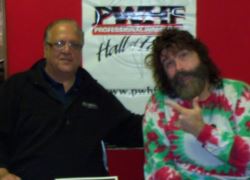
Tony Vellano with Mick Foley at a PWHF signing.
John Pantozzi, a ring announcer and longtime PWHF supporter, recalls the time when Tony became the weekend chauffeur for Mil Mascaras when Mil came to Amsterdam to accept his induction ring. The Mexican wrestler decided to surprise fans with his appearance and did not want anyone to know he was arriving since he would not be wearing his mask on the plane and other local areas. He stayed at a different, and relatively distant, hotel with Tony providing personal attention to Mil’s needs for anonymity.
On another occasion, Pantozzi was able to have his friend Mick Foley conduct a fundraising autograph session at the hall. Foley refused any compensation except for a sandwich to take on the road with him.
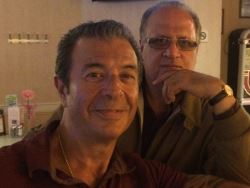
Mike Capano and Tony Vellano.
Success begets success and a number of PWHF supporters were inspired to host their own events to further the hall’s mission to memorialize the heroes and villains of the mat. These fundraisers consisted primarily of dinners combined with raffles for various wrestling souvenirs. John Pantozzi, SLAM! Wrestling’s Producer Greg Oliver along with the Magen brothers and Andy Stefanides, Dr. Michael A. Martini, “Irish” Davey O’Hannon, “Pretty Boy” Larry Sharpe and Terry Gunn were among the organizers who stepped up to promote the hall in this manner. Hardworking PWHF Vice-President Mike Capano drove Tony and I to a Staten Island dinner featuring Bret Hart, Ted DiBiase and Mick Foley, who all appeared without remuneration. We had no idea if expenses would outpace ticket sales but on the trip there Tony stated, “If we come back with one more dollar than we had before the dinner, it will be a success.” Consistently moving forward, even in small incremental steps, is one of the reasons that the PWHF exists today.
I don’t think Tony ever figured that he would be the PWHF president for 16 years. When he talked about letting another person take the reins during the formative years, he did not seem to realize that there was no one else who could handle such duties as those that he placed upon himself. About 10 years ago, Tony asked me if I would be interested in becoming the PWHF president. Without hesitation, I declined telling him that I did not have the time and, more importantly, I did not have the talent. How Tony performed year-round tasks for the PWHF while maintaining his business and family life will remain a mystery to those of us who watched that decade-and-a-half of his life.
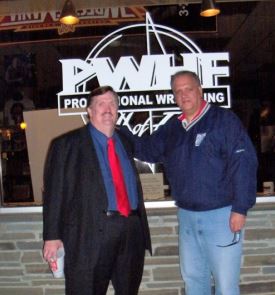
Percy Pringle III / Paul Bearer visits with Tony Vellano at the PWHF.
The time did come when further growth of the PWHF would require more cooperation from local and state government as well as the support of large businesses in the area. Tony decided that the PWHF would accept the overtures from Wichita Falls, Texas and ultimately the PWHF moved there. Some regulars at the New York inductions were quite shaken over the loss of their yearly pilgrimage to Schenectady and later Amsterdam and they did not fail to colorfully express their sense of disbelief. I fully understood their grief but could not blame Tony in any way, shape, form or manner for making the decision that he did because I saw firsthand the profound, continuous effort required of Tony to maintain the PWHF’s presence in New York. After 16 years, Tony deserved and needed some time to revisit all the things he postponed while ministering to the PWHF needs.
During the 14 inductions that took place during Vellano’s PWHF presidency, there was a common underlying theme that the inductees conveyed during their acceptance speeches. Their prevailing sentiment was an expression of gratitude to Tony and staff for providing a place of dignity for them and their colleagues by instituting a legitimate system of perpetual recognition. It appeared that being chosen via a thorough vetting process by their peers and by respected wrestling historians really made heartfelt impressions on them. They knew that the PWHF was not a commercial venture but rather a sincere effort to publicly recognize a slice of popular Americana that had been largely neglected prior to the PWHF.
PWHF and WWE Hall-of-Fame inductee JJ Dillon recently shared some thoughts on Vellano. “I refer to Tony as ‘Saint Tony’ because he is a saint to me,” said Dillon. “As I got to know Tony, I recognized that he is a very successful businessman that seems driven to accomplish what others might think is an impossible task. What Tony started and dedicated himself to in a small depressed upstate New York town is nothing short of remarkable. A community that lacked upscale hotels and restaurants and a community that struggled to survive let alone support the vision of a Tony Vellano. For 15-plus years the PWHF and Museum exceeded the highest expectations of everyone.”
Sainthood did not come without effort. As Vellano said in April 2017, the PWHF was “the hardest job I ever had.”
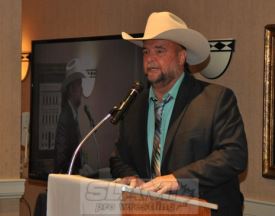
John Mantell at the PWHF induction ceremony in Amsterdam in May 2015, the last year it was in New York State. Photo by Wayne Palmer
Throughout Vellano’s PWHF presidential tenure, if money could be saved, he would find the way. I remember witnessing him remove a non-cancelled stamp from an envelope to save the PWHF half a dollar. When we traveled to the Cauliflower Alley Club reunion in Las Vegas or even to out-of-town PWHF fundraisers, we all paid our own way. Everyone, including Tony, paid for their own banquet tickets as well.
When I was asked by John Lusk, a.k.a. Cowboy Johnny Mantell, the new PWHF president, to chair the 2016 PWHF Screening Committee, I accepted as long as we could continue as it had been done in all previous years, i.e. via email, telephone and mail. Lusk told me that the new PWHF administration wanted to fly all three members of the committee into Texas with all expenses paid, even though one man who I wanted on the committee lived in Japan. I could not bear to see our hard-earned money spent in such a fashion so, for that and other reasons, I declined. Even though the cost was to be “sponsored” by a donor, it was still money that could have been invested into the PWHF with infinitely more efficiency and effectiveness. I asked Tony what he thought about the PWHF changing its policy to allow such spending and he replied “dumb.”
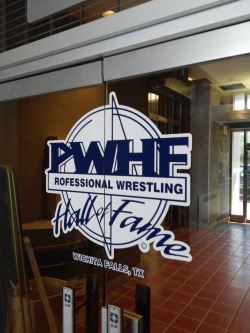
The doors are open to the PWHF in Wichita Falls, Texas, now.
Besides preserving various artifacts from the history of professional wrestling, Vellano’s other main goal was to establish a legitimate induction process. One aim was to prevent cliques or “voting blocs” from controlling who would be inducted as we all wanted to avoid favoritism. To that end, we established a Screening Committee consisting of three persons who would formulate a ballot, upon which a Board of Selectors would vote. The Board of Selectors initially consisted of 30 people, roughly half of which were wrestlers and the other half wrestling historians. We later increased that number to 40 but retained an approximate 50-50 split between wrestlers and historians. Each year, we rotated the Selectors in order to avoid the potential of collusion in the voting process. I asked Tony what he thought about the 2016 change in voting protocol, which allows a fixed base of wrestlers to vote with a smaller number of historians participating, thus potentiating a subversion of the legitimacy we sought. Tony’s response was “dumber.”
Make no mistake about the following fact: There is only one person in the entire world who had the combination of foresight, leadership, unbridled tenacity, business experience, patience, physical and mental energy, congeniality, and boldness to establish a successful shrine for the wrestling community and that man was Tony Vellano. To quote Tony, “the Hall wasn’t a pill dropped in water and that it just formed. The Hall was a hard rigorous experience … with many doors opening and just as many closing … but I never quit, I kept going.”
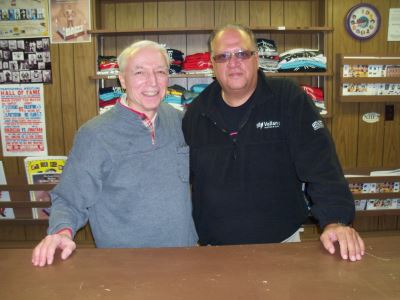
Dr. Bob Bryla and Tony Vellano share a quiet moment after the PWHF had closed for good in Amsterdam.
RELATED LINKS
